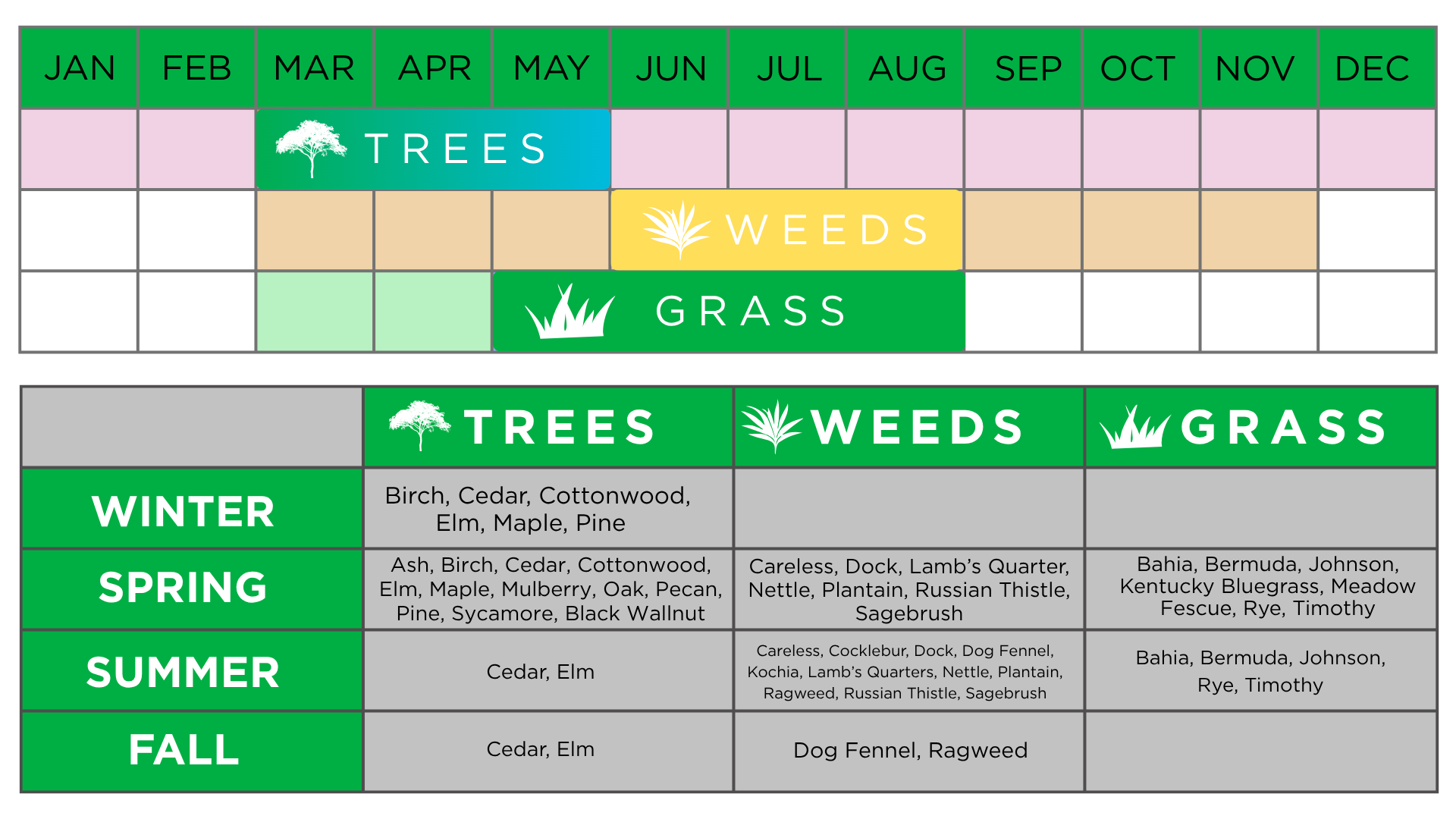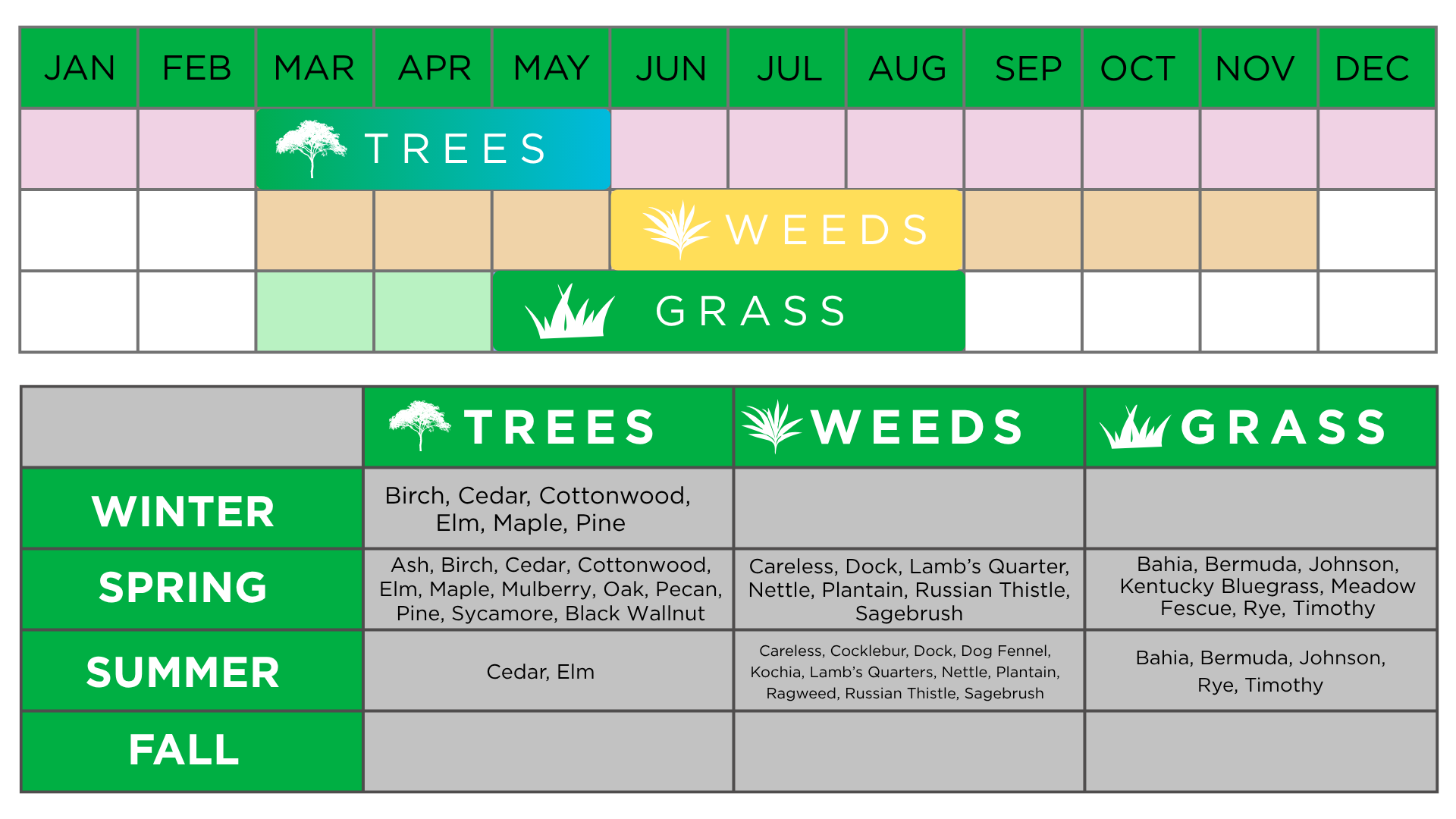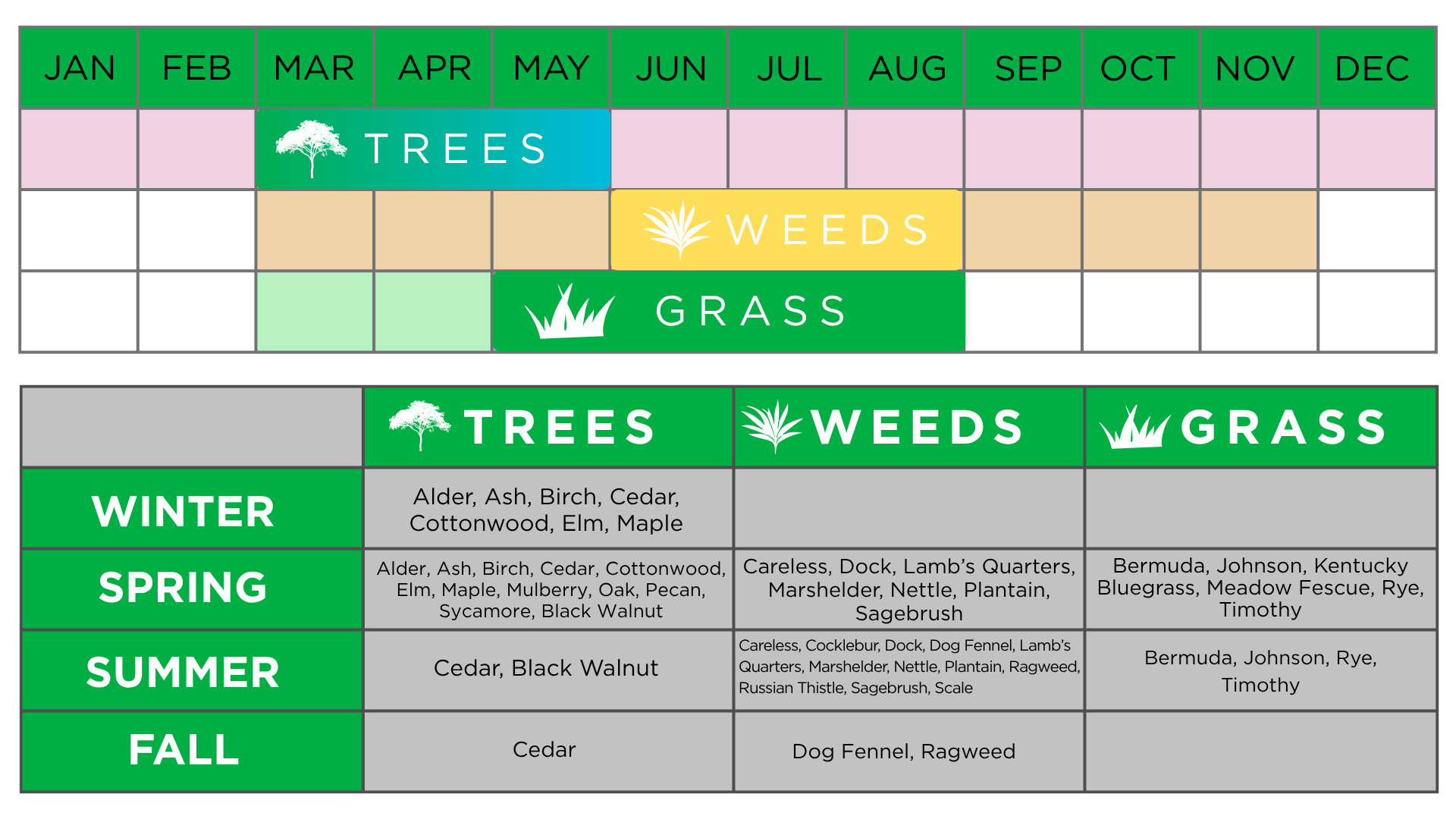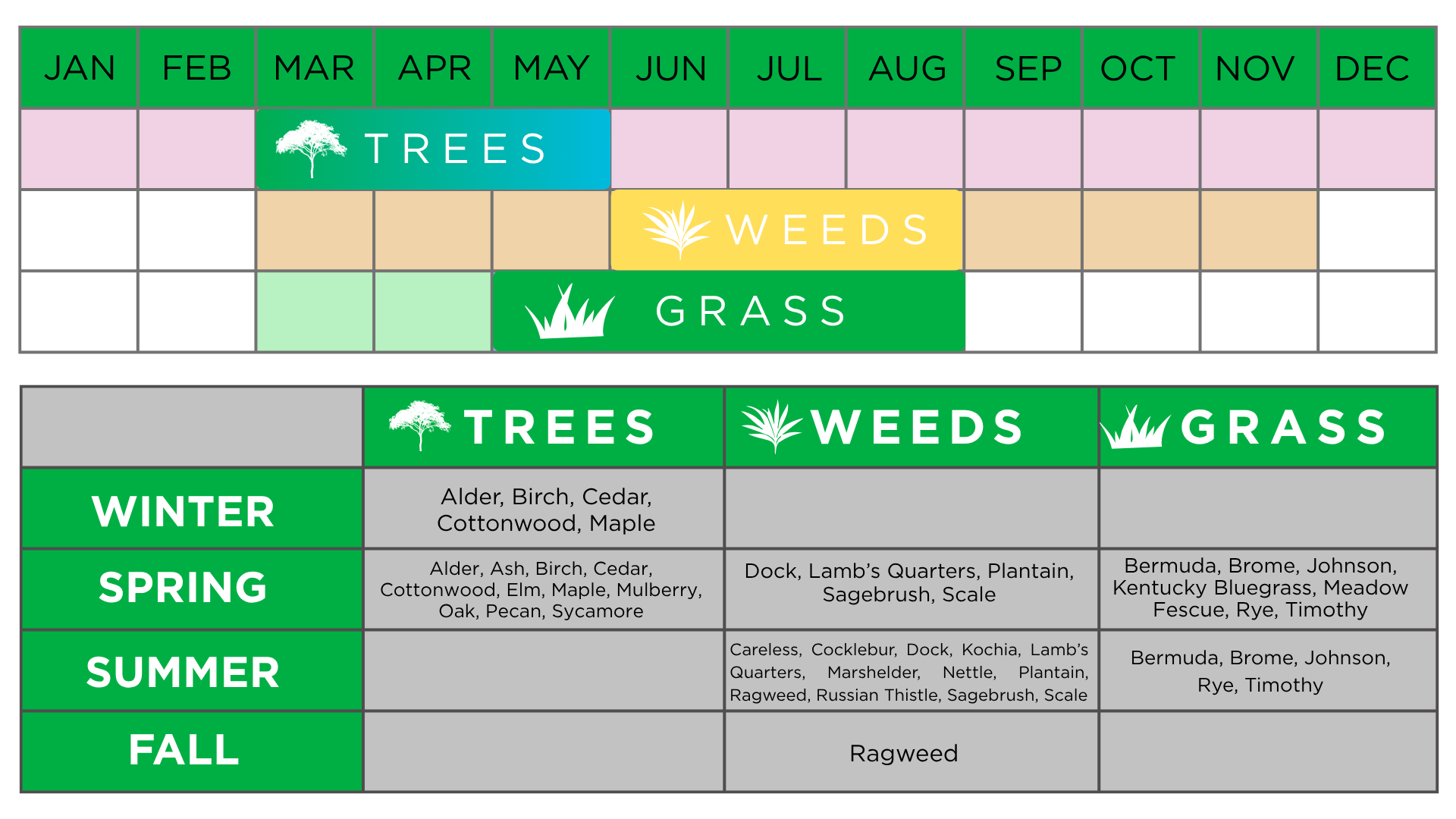Shop by

Seasonal allergies don't follow a simple calendar. While many people think spring is the only time to worry about pollen, the reality is that allergy season can last 6-9 months in most U.S. regions. From tree pollen in early spring to ragweed in fall, understanding when allergens peak in your area can help you prepare and manage symptoms more effectively.
This guide breaks down exactly when allergy season starts across different U.S. regions, what triggers symptoms throughout the year, and how you can create a safer indoor environment during peak allergy times.
Allergy season begins when plants release pollen into the air as part of their natural reproduction cycle. The timing depends on several factors, but temperature and weather patterns play the biggest role.
Tree pollen kicks off allergy season in most regions. Trees like oak, birch, cedar, and maple release pollen as early as January in warmer climates and as late as May in colder areas. These tiny particles can travel hundreds of miles on wind currents.
Grass pollen follows tree pollen, typically peaking from late spring through summer. Common grass allergens include Timothy, Bermuda, and Kentucky bluegrass.
Weed pollen dominates fall allergy season. Ragweed is the biggest offender, producing up to 1 billion pollen grains per plant. Other weeds like sagebrush and pigweed also contribute to fall symptoms.
Mold spores can trigger allergies year-round but often peak in fall when leaves decompose. Unlike pollen, mold thrives in damp conditions and can be found both indoors and outdoors.
Temperature changes signal plants to start their reproductive cycles. A few warm days in late winter can trigger early tree pollen release, while cold snaps can delay it. Rain washes pollen out of the air temporarily, providing relief. However, it also helps plants grow, potentially leading to higher pollen counts later.
Wind speed and direction affect how far pollen travels and how concentrated it becomes in different areas. Dry, windy days typically bring the highest pollen counts.
Allergy season varies dramatically across the United States. Here's what to expect in each major region:
States: Florida, Georgia, Alabama, South Carolina, North Carolina, Tennessee, Kentucky, Virginia, West Virginia, Louisiana, Mississippi, Arkansas
Allergy Season: January through October
The Southeast experiences one of the longest allergy seasons in the country. Tree pollen starts as early as January, with cedar and juniper leading the way. Spring brings intense tree pollen from oak, hickory, and pine trees. Summer grass pollen overlaps with late tree pollen. Fall ragweed season can be severe, lasting from August through October.
Peak months: March-May (trees), June-August (grass), August-October (ragweed)

States: Arizona, New Mexico, Nevada, Utah, parts of California, Colorado
Allergy Season: February through September
Desert climates create unique allergy patterns. Tree pollen from mesquite, palo verde, and mulberry trees starts in February. Grass pollen is less common due to lower humidity, but Bermuda grass can still cause problems. Fall brings ragweed and sagebrush pollen.
Peak months: March-May (trees), May-July (grass), August-September (weeds)

States: Maine, New Hampshire, Vermont, Massachusetts, Rhode Island, Connecticut, New York, New Jerse, Pennsylvania
Allergy Season: March through September
Cold winters delay the start of allergy season, but spring can hit hard when it arrives. Tree pollen from maple, birch, and oak dominates March through May. Grass pollen peaks in early summer. Ragweed season runs from August through the first frost.
Peak months: April-May (trees), June-July (grass), August-September (ragweed)

States: Illinois, Indiana, Iowa, Kansas, Michigan, Minnesota, Missouri, Nebraska, North Dakota, Ohio, South Dakota, Wisconsin
Allergy Season: March through October
The Midwest experiences intense grass and ragweed seasons. Tree pollen from oak, ash, and maple starts in March. The region's abundant grasslands create high grass pollen counts from May through July. Ragweed season can be particularly severe, lasting from August through October.
Peak months: April-May (trees), May-July (grass), August-October (ragweed)

States: Washington, Oregon, northern California, Idaho, Montana, Wyoming
Allergy Season: February through September
The Pacific Northwest's mild, wet climate creates unique challenges. Tree pollen from alder, birch, and cedar starts in February. Grass pollen peaks in late spring and early summer. Mold spores can be a year-round problem due to frequent rain and humidity.
Peak months: March-May (trees), May-July (grass), year-round (mold)

States: Texas, Oklahoma, Arkansas, Louisiana
Allergy Season: January through September
This region experiences some of the earliest and longest allergy seasons. Cedar fever in Texas can start in December and last through February. Tree pollen continues through spring, grass pollen dominates summer, and ragweed extends well into fall.
Peak months: December-February (cedar), March-May (trees), June-August (grass), August-September (ragweed)

For most Americans, allergy season runs from January through September - that's 8-9 months of potential exposure. However, the exact duration depends on your location and local climate patterns.
Climate change has extended allergy seasons in many regions. Warmer temperatures allow plants to pollinate earlier and later in the year. Some areas now experience allergy seasons that are 2-3 weeks longer than they were 20 years ago.
Local weather patterns can shift timing from year to year. A mild winter might trigger early tree pollen, while a late spring could delay grass pollen season.
Geographic location plays the biggest role. Southern states typically experience longer seasons, while northern regions have shorter but more intense periods.
Weather conditions before and during pollen season affect how much pollen plants produce. Wet springs often lead to more plant growth and higher pollen counts. Consecutive dry years can stress plants, potentially reducing pollen production.
Temperature fluctuations can also concentrate pollen release. If warm weather triggers early pollination followed by a cold snap, plants may release more pollen when temperatures rise again.
Understanding when different allergens peak helps you prepare for the worst symptoms:
Tree pollen season typically peaks in mid-to-late spring, though timing varies by region. In the South, tree pollen can start in January and peak by March. Northern states might not see peak tree pollen until May.
Common tree allergens include:
Grass pollen season overlaps with late tree pollen in many areas. Peak grass pollen typically occurs in early summer when temperatures are warm and humidity is moderate.
The most allergenic grasses include:
Fall allergy season is dominated by ragweed, which can produce pollen from August until the first hard frost. Other weeds like sagebrush and pigweed contribute to fall symptoms.
Ragweed pollen can travel hundreds of miles, so you might experience symptoms even if ragweed doesn't grow in your immediate area.
While you can't control outdoor pollen levels, you can significantly reduce your exposure indoors. The key is understanding how allergens enter your home and taking steps to filter them out.
Outdoor allergens become indoor problems when they're carried inside on clothing, shoes, pets, and through open windows and doors. Even with windows closed, allergens can enter through small gaps and be pulled in by your HVAC system.
Indoor allergens like dust mites, pet dander, and mold can worsen symptoms year-round. During allergy season, the combination of indoor and outdoor allergens can be overwhelming.
Pollen particles are incredibly small, typically 10-100 microns in diameter. They easily stick to clothing, hair, and shoes. Opening windows and doors creates direct pathways for allergens to enter. Your HVAC system can also pull outdoor air (and allergens) inside if it's not properly configured.
Regular cleaning helps, but air filtration is more effective for removing airborne allergens. Your HVAC system's air filter is your first line of defense against indoor allergens.
Most homes come with basic fiberglass filters that barely capture large particles. Upgrading to a higher-efficiency filter can remove 95% or more of airborne allergens, including pollen, dust, and mold spores.
The easiest way to control allergens indoors? Regularly replace your air filters. Filterbuy makes it effortless with automatic delivery and high-quality filters designed to trap even the smallest allergens.
Managing seasonal allergies requires a combination of strategies. Here's what works best:
Reducing your exposure to outdoor allergens like pollen can help minimize allergic reactions. Simple strategies include keeping windows closed during peak pollen hours, showering after spending time outside, and drying laundry indoors to prevent pollen from clinging to fabrics.
Over-the-counter antihistamines and nasal sprays can provide quick relief from allergy symptoms like sneezing, a runny nose, and itchy eyes. Always consult with a healthcare provider to determine the best medication for your needs.
For those with severe or persistent allergies, immunotherapy such as allergy shots might be worth exploring. These treatments help your body build resistance to allergens over time, offering lasting relief and reducing dependency on other medications.
Using HEPA purifiers in your home can significantly reduce allergens in the air. Additionally, installing high-MERV HVAC filters traps microscopic particles like pollen, dust, and mold spores. These filters are specifically designed to improve indoor air quality and safeguard against common allergy triggers.
Filterbuy’s pleated MERV 13 filters help trap airborne pollen, dust, and spores. Made in the USA and shipped free.
Allergy season might feel like a force of nature, but with the right preparation, you can reclaim your home as a safe haven. Whether you're fighting tree pollen in spring or ragweed in fall, the key to managing symptoms starts inside your home. By using high-quality HVAC filters from Filterbuy, you're taking one of the most effective steps to breathe easier year-round. Explore our full range of air filters now and enjoy free U.S. shipping on every order.
Spring (March to May) and fall (August to October) are the worst months for allergies in most U.S. regions. Spring brings high tree pollen counts, while fall is dominated by ragweed and mold spores. Allergy severity can vary depending on local vegetation and climate.
Yes. In warmer regions like the South and Southwest, allergy season can begin in January or February. Trees such as juniper and elm may start releasing pollen even in late winter, triggering early allergy symptoms.
Pollen levels are typically higher in the early morning hours and after sunset. Indoors, accumulated allergens from the day can also circulate through your HVAC system overnight if filters aren’t regularly replaced.
Keep windows closed during peak allergy season to prevent pollen and other airborne allergens from entering your home. Use an HVAC system with clean air filters to circulate and purify indoor air instead.
During allergy season, it’s best to replace your HVAC filters every 1 to 3 months. If pollen counts are high or someone in your household has severe allergies, replacing filters more frequently may be necessary. Filterbuy’s Autoship program ensures you never miss a change.
Standard air filters may not capture the smaller particles that trigger allergies. For effective allergy relief, use pleated MERV-rated filters (preferably MERV 11 or 13) from trusted providers like Filterbuy.
Yes. High-efficiency filters with a MERV 13 rating are best suited for people with asthma or severe allergies. These filters trap ultra-fine particles like smoke, bacteria, and allergen triggers, improving indoor air quality significantly.
Other strategies include using a HEPA air purifier, vacuuming with a HEPA filter, showering after outdoor exposure, washing bedding weekly, and keeping pets clean. Still, replacing air filters remains the most effective low-effort solution for whole-home air quality.
Filterbuy provides U.S.-made, pleated HVAC filters in MERV 8, 11, and 13 options—perfect for allergy season. With over 600 standard sizes and custom sizing available, Filterbuy’s Autoship program ensures you always have clean filters ready before allergy symptoms spike.